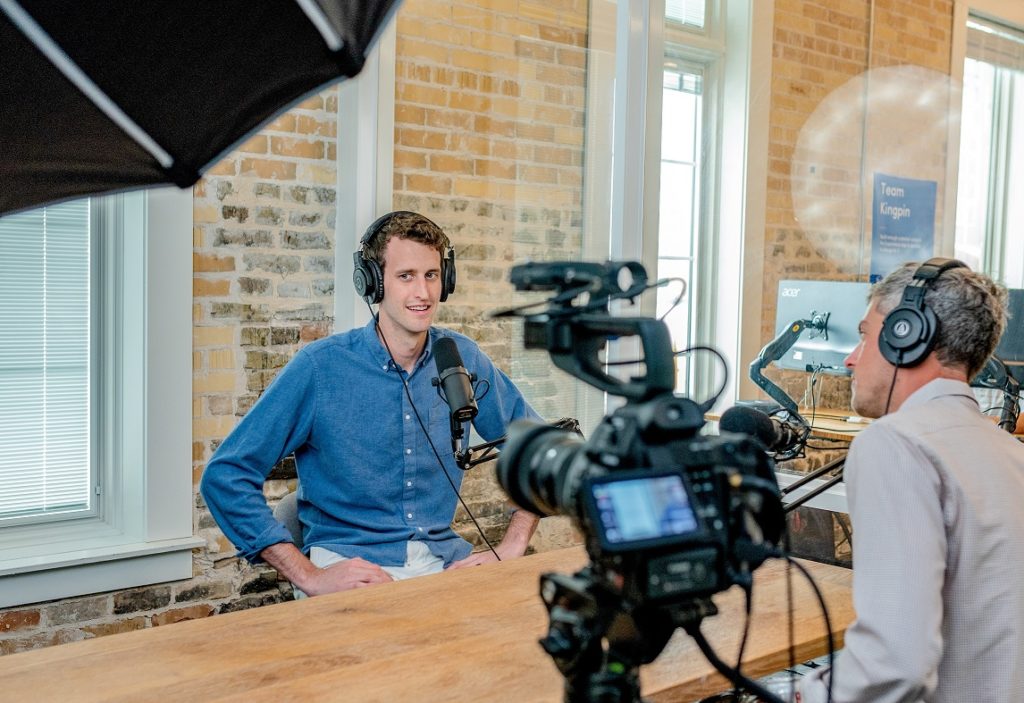Imagine, if you will, that you want to share a message with your team. You’re successful. You’re confident. You’re comfortable speaking in front of hundreds. You’ve done all the courses on generating presence and successful verbal delivery mechanisms. Hell, you might even be so bold as to say that you’re popular. People just naturally listen to what you have to say. You’re qualified. OVER qualified. You’re going to record a video message. You can get in, drop a message in one take, and get out. Easy…So, why is it, 3 days later, sat staring at the blinking red light above the camera, that you’ve pulled a total blank. Your delivery is bland. Words stick in your mouth. You have, in fact, completely lost track of what you wanted to say. There is a reason why TV presenters get paid so much, and you are just now realising what that reason is. Delivering something to a camera in a natural and engaging way is an artform.
Just as much as playing Sunday League football is not the same as taking on a Premier League team, or why cooking a nice casserole is not the same at getting your 3rd Michelin star; being a good leader, or even a good public speaker, doesn’t mean you are purpose-built to perform in front of a camera. If you want to truly build engagement through leadership videos, you must first be engaging. Many great corporate videos are engineered to entertain more-so than they are to inform. If you intend to hold someone’s attention for longer than a few minutes, you are going to need to reward them with something worth their while. This doesn’t mean that you need to be performing circus tricks or telling jokes (although levity is always a good tactic), but you need to know your message inside-out, so that you can focus more on HOW you say things more than what it is you want to say.
In our many years of helping clients creating engaging messaging, we have established 5 key areas which often make the difference between an appealing communication, and one that gets ignored entirely. But before we get into that, it is worth noting that you should always work in tandem with your PR or marketing department when putting together any form of communication. They are always a great sounding board for what will and won’t make for strong messaging. They will help you hone your text to ensure you get maximum impact. Kind of like this article. I doubt what I have written in my draft will be the finished article you see right now! You can always sprinkle some extra personality on it after, but this isn’t an experience you have to go through on your own. Do what all good leaders do; listen to others.
Now, onto our 5 tips for building better engagement through leadership videos…

Don’t Be Like Shelley.
There are two types of confidence. One is too much, and the other is not enough. Another term for confidence could be certainty. And when it comes to certainty, you are either right to think you’re right, or think you’re right but your wrong. There is nothing more infuriating than the embarrassment of assuming “you’ve got this”, only to find out that you really don’t. Multiple takes can be a massive downer for anyone.
Legend has it that Stanley Kubrick put Shelley Duvall through a record-setting 127 takes for the infamous baseball bat scene in The Shining. The sequence is a simple one. Shelley’s character, Wendy, must walk up a staircase crying whilst swinging a bat. Kubrick, ever the perfectionist, was never quite sold on Wendy’s level of hysteria. Sources close to Kubrick suggest that he put Duvall through an arduous 127 takes in order to “break her down”. The end result is a terrifying mixture of exhaustion and endurance, for a character (and at this point, actress) on the brink of delirium.
This may have worked for Kubrick and his film, but only at Shelley Duvall’s expense. Hopefully, you will never have to deliver 127 takes, but after 5, the rest all feel like you’re just swinging a bat and crying. Things begin to unravel, and before you know it, the take you end up using will be a “that’ll have to do”-one. So, be as confident as you want, but unless you are certain you know what your messaging will be and have memorised the things you want to say, then you better take our next piece of advice to heart.
Prepare The Helen Mirren Way.
British acting legend Helen Mirren knows a thing or two about remembering lines. The Oscar winning actress started her career in the Royal Shakespeare Company in the late 60’s, and has been performing on stage, TV and in film ever since. For Mirren, the key to good delivery and engagement is learning your lines. “Improv can be inspired and great, or it can be mundane and boring and stupid. So, improv isn’t always the answer.” [1]
You don’t have to speak a script verbatim (unless you do), but ‘winging it’ on camera or relying on an autocue, is not the way to go…unless you know your lines. If you do indeed have a natural charisma and rapport with your team, then they will see when you are saying words vs speaking them. In her masterclass on acting, Mirren states. “if you’ve learned your script so well. So immaculately well. Then you don’t even have to think about it.”[2]
So, what can you do to prepare? Well, according to Mirren, first of all NEVER rehearse in front of a mirror. Looking at yourself perform is easily a shortcut to becoming self-conscious.
- Deconstruct your script. Figure the milestones of what you are trying to say. Break it down into small sections.
- Memorise your lines a section at a time. You don’t need to know it all at once. Read them out loud. Write them down. Say them to a friend.
- Repeat. Repeat. Repeat.
- Get to know your message. Knowing your message at a gut instinct level, will allow you to take our next tip in your stride.

Heed Robert Burns.
In his poem ‘To a Mouse’, Robert Burns famously wrote; “The best-laid schemes o’ Mice an’ Men
Gang aft agley”[3]. No amount of preparation will protect you from a last-minute marketing pivot or a sudden change in direction for your messaging. You might have emergency meetings that mean re-scheduling your filming, or some impending plans that give you less time to deliver. You may even need to prepare and deliver multiple messages for different audiences. There is a plethora of reasons why being adaptable is important.
Being adaptable means that you can find solutions in the unknown or embrace the opportunity to be creative (see our next tip). But being adaptable doesn’t give you autonomy to ignore all of the preparation that has gone into getting you to this point. Remember, you don’t want to end up like Shelley! So, if the circumstances arise that require some adaptability, then consider your plan of attack. Do you need to postpone for a few days to re-write and learn your new script? Should you consider filming in sections so that you can better remember these new small chunks of dialogue, and edit them together? Could you change the approach to suit the new messaging? Maybe consider a different style of delivery? Whatever you do, don’t let changes in circumstance cause you to stumble and press on regardless.
For those who do not have an adaptable personality, you might need to consider the possibility that delivering a message for the sake of meeting a deadline will not be the best course of action. Better to shift a deadline than output an asset that will be detrimental to your personal brand. Adaptability isn’t always an immediate course action. Sometimes, just pressing pause and taking a moment to think is just as effective. Remember, the more you believe in the messaging, the more engaging your delivery will be.
Hold More Snakes.
David Kelley, creator of IDEO, gave a wonderful TED talk in 2012 titled ‘How to build your creative confidence’. In it, he speaks of how “non-creative” people distance themselves from the idea of being creative, because at some point in their life they have decided or have been told that this is an area where they are lacking in skill.
The main body of Kelley’s talk focuses on renowned psychologist Albert Bandura, and his experiments to help people deal with fear. Studies showed that by incremental exposure to an object of fear, such as a snake, one could in a matter of hours not only deal with their fear but actually learn to embrace the thing they once abhorred.
When it comes to engaging with your teams through video messaging, never fear the creative. Dare to try things, become comfortable with failure. You might reconsider the presentation of your message, the language used, even the delivery optics. You might want to try a few different things and see which land best. There is often an in-built fear for “non-creative” people, that If you don’t say the right creative thing or execute your creative vision seamlessly, you’ll be judged. But this simply is not true. George Lucas was once told that no one would watch a space opera about shiny robots and bad guys with asthma; and look how that turned out!
Referring back to Albert Bandura, Kelley mentions the concept of self-efficacy. This is, in essence, self-belief. When it comes to being creative, the best gauge is often to judge something by your own standards of enjoyment. If you deliver a message in a way that you would respond to as an audience member, then others are bound to respond in a similar way.
We all have our personal brand and our corporate identity to uphold. But building on that brand doesn’t mean you are ignoring it. Being creative is a way of finding new and exciting ways to communicate with others. If Burger King can urge their customers to purchase a Big Mac, then you can definitely afford yourself some creative license when considering your video concept.

Tell Us A Story.
If you read any news article, you will likely find that the good ones often follow a narrative structure. Stories give our messages context. The why, the how, the what next. They give us something to invest in, to follow and to hope for. Below are two very different versions of the same message. To make it fair, we will use a similar number of words and talk about the same things. You decide which is more effective.
“We are changing the way we complete our year-end reviews. We need to look at things a little differently. You will meet with your line manager. Don’t worry, this will be a fair review. You have had a tough year, and we understand. When the review happens, make sure you fill out your personal performance form. To know more, speak to your line manager. We will see you soon.”
“This has been a very tough year. We know you have been through a lot, and we recognise your efforts. So, when it comes to your end-of-year review, we want you to know things will be a little different this time. We want your review to be fair, to be honest, and we want you to be confident when completing your personal performance form. Want to know more? Set an appointment with your line manager today. We will see you soon.”
By putting your audience IN the story, you give them something to be invested in. You give them a roadmap to follow in their minds, a narrative arc. A beginning (the situation), a middle (what this means for you), and an end (what we need to do next).
There are a number of other things you might want to consider when creating your video messaging. Practical elements such as lighting, location, and your outfit, are all important, but pale in comparison if the messaging is not correct. These cosmetic changes might feel like they will make for a more engaging message, but as the idiom goes, if your engagement isn’t there, then “you can’t put lipstick on a pig.”
So, next time you find yourself considering the output of a short video to promote engagement; don’t be like Shelley, prepare the Helen Mirren way. Heed Robert Burns; hold more snakes and tell us a story.
OnTrack work closely with you to combine our talents and resources in the way that works best for your people and will prove most effective in bringing about the improvements you require.
Get in touch with OnTrack to find out more about how you can build engagement through leadership videos today.
[1] Helen Mirren. Acting Masterclass. Lesson 5; Breaking Down a Script. 2019.
[2] Helen Mirren. Acting Masterclass. Lesson 15; Preparation. 2019.
[3] Burns, Robert, ‘To a Mouse, on Turning Her Up in Her Nest with the Plough’, November, 1785.



